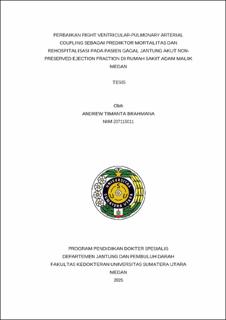| dc.contributor.advisor | Nasution, Ali Nafiah | |
| dc.contributor.advisor | Raynaldo, Abdul Halim | |
| dc.contributor.author | Brahmana, Andrew Timanta | |
| dc.date.accessioned | 2025-10-10T02:53:23Z | |
| dc.date.available | 2025-10-10T02:53:23Z | |
| dc.date.issued | 2025 | |
| dc.identifier.uri | https://repositori.usu.ac.id/handle/123456789/109229 | |
| dc.description.abstract | Objective:
To evaluate the improvement in right ventricular–pulmonary artery (RV–PA) coupling;
measured by the tricuspid annular plane systolic excursion/pulmonary artery systolic
pressure (TAPSE/PASP), during hospitalization as a predictor of mortality and
rehospitalization within six months after treatment in patients with acute heart failure
(AHF) with non-preserved ejection fraction (non-HFpEF) at Adam Malik General
Hospital, Medan.
Methods:
This study was an analytical study with a retrospective cohort design involving patients
with AHF non-HFpEF treated at Adam Malik General Hospital between January 2023
and January 2025. RV–PA coupling was assessed using the TAPSE/PASP ratio obtained
through transthoracic echocardiography (TTE) at admission and discharge. Statistical
analyses were conducted to evaluate the association between changes in the RV–PA
coupling and six-month outcomes of mortality and rehospitalization post-discharge.
Results:
A total of 62 patients were included, predominantly 48 patients (77.4%) were male, with
a mean age of 60 years. Hypertension was the most common comorbidity in 41 patients
(66.1%), and 48 patients (77.4%) of subjects had a sinus rhythm. The most frequently
observed AHF phenotype was acute decompensated heart failure (ADHF) at 30 patients
(48.4%). At follow-up, 32 patients (51.6%) experienced mortality or rehospitalization
within six months after discharge. Analysis showed that increased TAPSE/PASP, with
increase of TAPSE of ≥1 mm or just overall with cutoff 0.39 and 0.53, respectively, was
significantly associated with lower rates of 6 months post mortality or rehospitalization.
However, multivariate analysis revealed RV-PA coupling improvement as an
independent factor in mortality or rehospitalization, with no significant impact of
supportive therapy during hospitalization or guideline-directed medical therapy discharge
on (GDMT <3 out of 4) on these outcomes.
Conclusion:
Improvement of RV–PA coupling during hospitalization may serve as a substantial noninvasive
predictor of mortality and rehospitalization for 6 months in patients with AHF
non-HFpEF. This measurement could be broadly applied in clinical practice to improve
risk stratification and guide patient management. | en_US |
| dc.language.iso | id | en_US |
| dc.publisher | Universitas Sumatera Utara | en_US |
| dc.subject | AHF | en_US |
| dc.subject | non-HFpEF | en_US |
| dc.subject | RV–PA coupling | en_US |
| dc.subject | mortality | en_US |
| dc.subject | rehospitalization | en_US |
| dc.subject | predictor | en_US |
| dc.title | Perbaikan Right Ventricular Pulmonary Arterial Coupling sebagai Prediktor Mortalitas dan Rehospitalisasi pada Pasien Gagal Jantung Akut Nonpreserved Ejection Fraction di Rumah Sakit Adam Malik Medan | en_US |
| dc.title.alternative | Right Ventricular–Pulmonary Arterial Coupling Improvement as Predictor of Mortality and Rehospitalization in Patients with Acute Heart Failure with Non-Preserved Ejection Fraction at Adam Malik General Hospital, Medan | en_US |
| dc.type | Thesis | en_US |
| dc.identifier.nim | NIM207115011 | |
| dc.identifier.nidn | NIDN0014048104 | |
| dc.identifier.nidn | NIDN0026118204 | |
| dc.identifier.kodeprodi | KODEPRODI11715#Ilmu Penyakit Jantung dan Pembuluh Darah | |
| dc.description.pages | 122 Pages | en_US |
| dc.description.type | Tesis Magister | en_US |
| dc.subject.sdgs | SDGs 3. Good Health And Well Being | en_US |


